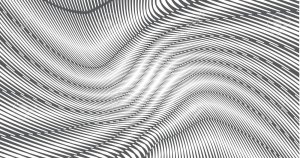Errors are abundant when measuring objects, and we have continually come across this within our series of articles. Image processing in 2 dimensions is vital for transforming images into a 3D structure. This includes extruding a 2D image into 3D as well as stitching 2D images to create a 3D image. Today we will learn about an effect in photography that many of us notice, but are not aware of its terminology. We will also look into how this affects metrology and, subsequently, 3D printing.
The Moire Effect refers to a pattern that is created in images occasionally. A moire pattern is a large in magnitude interference pattern. This can be produced with an opaque pattern that has transparent gaps overlaid within it. To see a large display of the moire interference pattern, two patterns cannot be identical in nature. The patterns have to be rotated or have a slightly different pitch. Overall it is a pretty trippy visual and it messes with our typical human perception in a variety of ways.
Constructing 3D images from 2D images is a difficult problem. An object that is 3D scanned is vulnerable to the moire effect. When doing a 3D print, the moire effect arises when you notice zebra like stripes on the surface of a print. To stop this it is critical to have great image processing on the 2D level. It seems as though it is nearly impossible to make a roughly perfect 3D image because of the impossibility of creating a perfect 2D image. This is okay, but we are still trying to attain the highest precision possible.
There is a lot of interesting math behind this effect as well. The essence of the moiré effect is the (mainly visual) perception of a distinctly different third pattern which is caused by inexact superimposition of two similar patterns. The mathematical representation of these patterns is not trivially obtained and can seem somewhat arbitrary. In this section we shall give a mathematical example of two parallel patterns whose superimposition forms a moiré pattern, and show one way (of many possible ways) these patterns and the moiré effect can be rendered mathematically.
The visibility of these patterns is dependent on the medium or substrate in which they appear, and these may be opaque (as for example on paper) or transparent (as for example in plastic film). For purposes of discussion we shall assume the two primary patterns are each printed in greyscale ink on a white sheet, where the opacity (e.g., shade of grey) of the “printed” part is given by a value between 0 (white) and 1 (black) inclusive, with 1/2 representing neutral grey. Any value less than 0 or greater than 1 using this grey scale is essentially “unprintable”.
When is the Moire Effect most prevalent? A terminology that is important to understand within metrology is strain measurement. Strain is a measure of the deformation of a body due to a force being applied to it. Strain is also the mathematical change in dimension of a body when a force is applied. Thus, strain measurement is focused on document the changes within dimension based on force applications. This is great when we want to measure deformations, but not for when we want to remove the possibility of them occurring through a 3D print. There are image scanners that have a descreen filter. These filters typically remove Moire-pattern artifacts. These are produced when scanning halftone images to produce digital images.
In conclusion, the Moire Effect as an interesting visual effect that occurs within the 2D realm and it readily affects the 3D world. With metrology technology, it is one of the various phenomena that can interfere with a high precision scan of an object.
Subscribe to Our Email Newsletter
Stay up-to-date on all the latest news from the 3D printing industry and receive information and offers from third party vendors.
You May Also Like
3D Printing Financials: Desktop Metal Targets Recovery Amid Net Losses and Revenue Downturn
Despite facing a decline in revenue and the persistent challenges of a tight economic climate, Desktop Metal (NYSE: DM) is making strides toward operational efficiency. The first quarter of 2024...
3YOURMIND & Nigerian Oilfield Services Firm RusselSmith Team Up on 3D Printed Part Inventory
3YOURMIND, the German and U.S. software services provider specializing in digital inventory platforms for additive manufacturing (AM), has partnered with Nigerian oilfield services firm RusselSmith to digitize spare part files...
Who is Endeavor 3D?
You may be familiar with our company, Endeavor 3D, or perhaps not. Located in Metro Atlanta, we are a contract additive manufacturer (AM) equipped with polymer 3D printing, stainless steel...
Titanium Powder Supplier IperionX Completes HAMR Furnace Installation at Virginia Campus
IperionX, the Charlotte-based manufacturer and supplier of US-sourced titanium products, has installed the Hydrogen Assisted Metallothermic Reduction (HAMR) furnace at its Titanium Manufacturing Campus in South Boston, Virginia. The company...




![{\displaystyle {\begin{aligned}f_{1}&={\frac {1+\sin(k_{1}x)}{2}}\\[4pt]f_{2}&={\frac {1+\sin(k_{2}x)}{2}}\end{aligned}}}](https://wikimedia.org/api/rest_v1/media/math/render/svg/7c7aa17b59e171f087bf00e4ea25e757a420e7e2)































